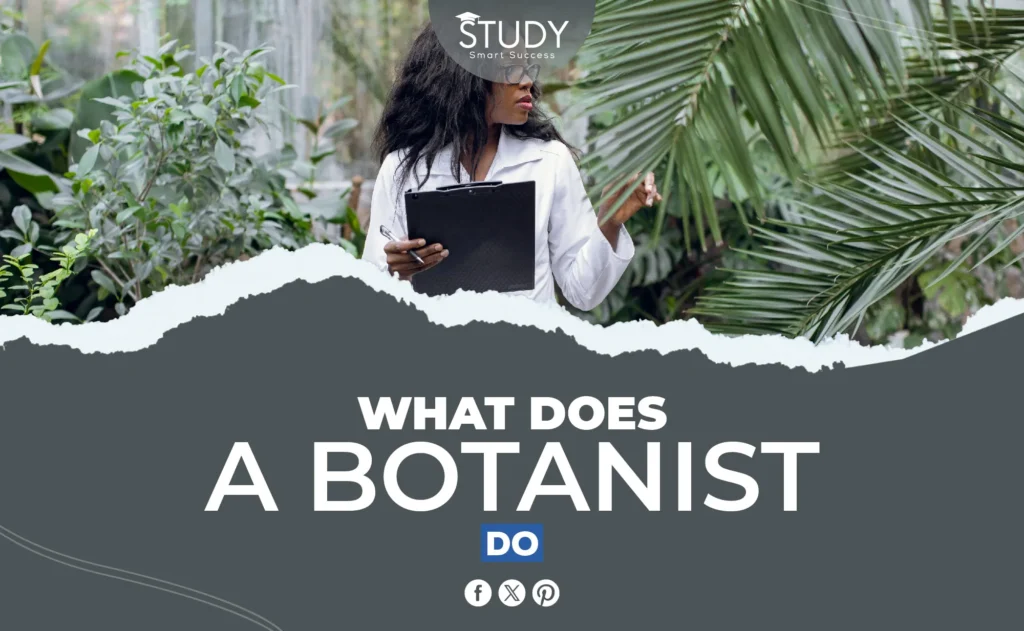Introduction
Biology’s botany branch studies plants. This includes their structure, growth, reproduction, metabolism, development, illnesses, chemical features, and interactions with other species. Or, What does a botanist do? Botanists examine these features to understand plants. Botany supports human life by supplying food, medicine, and ecosystems for other animals.
Botanists study plants, and their work benefits agriculture, conservation, environmental management, medicine, and education. They fix agricultural problems, safeguard endangered species, and explore novel ways plants might benefit humanity. Botanists are more vital than ever in climate change and environmental degradation.
Botany: The Study of Plants
It is hard to narrow down what botany is because it includes so many different areas of study. The word “botany” comes from the Greek word “botane,” which means “herb” or “plant.” Botany is one of the oldest studies. Its roots can be found in ancient civilizations when people first started to group plants based on their uses as food, medicine, and tools.
Modern botany goes beyond plant identification. Botanists investigate plant life from molecular mechanisms to global ecosystems. They study plant evolution, adaptation, and interactions with humans and other creatures. This knowledge is essential for food security, conservation, and sustainable agriculture.
Botany is the study of plants, but it also helps scientists understand biological principles in a larger sense. Plants are necessary for life on Earth because they make oxygen, support food chains, and keep environments in balance. Botanists’ work is significant for fixing problems with health, the environment, and climate change.
Responsibilities of a Botanist
Botanists do many different things; their duties can change based on specialization. Conversely, Botanists want to study and understand plants and how they fit into the world. Their daily tasks can include studying in the field, creating new types of crops, or investigating how plants can be used as medicine.
These are some of the main tasks that most botanists have to do:
Research and Study of Plant Species
Botanists’ main job is to study different kinds of plants, including how they are built, how they grow, how they reproduce, and how their genes work. This could mean going into the field to gather plant samples and information about the natural factors affecting plant growth.
Documenting Plant Growth and Behavior
Botanists carefully record how plants grow and behave in different situations. This can include tracking how plants react to temperature, wetness, or soil composition changes. This study is needed to understand how plants deal with climate change and diseases.
Identifying New Plant Species
Botanists work hard to find and label new plant species. This is very important in ecosystems that have yet to be visited or studied enough because that’s where new species might be found. Finding different kinds of plants helps protect variety and guides conservation efforts.
Studying Plant Genetics
Botanists help science advance by studying plant DNA and genetic structure. By learning about plant genetics, scientists can make crops more resistant to diseases, increase food yields, and make plants more resistant to environmental stresses like pests or drought.
Environmental Monitoring and Conservation
Botanists and environmental groups work together to monitor ecosystems and help protect species in danger of extinction. They are essential to conservation efforts because they advise restoring habitats, using safe farming methods, and protecting biodiversity.
Areas of Specialization in Botany
Plant science is a broad area that has many specialized branches that study different parts of plants. Botanists often focus on a particular study area based on their interests and work needs. Here are some of the most essential areas of expertise in botany:
- Plant Ecology: This field studies plant-environment interactions. Plant ecologists examine how plants interact with animals, fungi, and bacteria and how soil, water, and temperature affect plant health. Environmental changes like deforestation and climate change affect ecosystems, and biodiversity requires plant ecology.
- Agronomy: Agronomists are specialists who study how to grow crops and care for the land. They work to improve farming by creating high-yield, disease-resistant foods and making farming more environmentally friendly. Agronomy is integral to ensuring enough food for everyone, especially as the world’s population grows and more people need food.
- Plant Taxonomy: Taxonomists study how to group and name different types of plants. Plants are carefully examined, compared, and grouped in this area based on their traits. Plant taxonomists are crucial for tracking biodiversity and finding new species beneficial for medicine, the environment, or the economy.
- Ethnobotany: Folklorists who study ethnobotany examine how plants and people interact. This field focuses on learning how native and traditional communities use plants for spiritual rituals, food, medicine, and shelter. Ethnobotanists are crucial for keeping traditional knowledge alive and finding new drugs or goods made from plants.
These different areas of expertise help us learn more about plants in unique ways. They stress how important plants are to people and the earth.
Where Botanists Work
Botanists work in many places, from study centers and universities to private businesses and the government. Depending on their specialty, they may spend a lot of time researching in greenhouses, labs, or the great outdoors.
The following are some of the main fields where botanists work:
- Academic Institutions: Many botanists work in colleges and universities, where they teach, study, and write scientific papers. University botanists often lead long-term study projects that examine specific areas of plant science, like how climate change affects different plant species or how crops can be genetically modified.
- Government Agencies and Environmental Organizations: Botanists who work for environmental groups and the government often focus on ecosystem management, conservation, and environmental protection. They might protect rare species, fix up damaged habitats, or advise lawmakers on how to use land without harming the environment.
- Agricultural Industry: Botanists are important to farming because they help create new plant varieties and improve farming methods. They try to find solutions to problems like how to boost food yields, make plants more resistant to pests and diseases, and make plants that can grow in harsh environments.
- Pharmaceutical and Biotechnological Industries: Botanists are also very important in the biotech and pharmaceutical businesses, where they help find new medicines made from plants. They might examine plant chemicals to see if they have any health benefits and try to make drugs from plants that can be used in medicine.
Botanists often collaborate with people from other fields, such as ecologists, agricultural scientists, and pharmacologists, to ensure that their research helps solve problems in the real world.
Tools and Techniques Used by Botanists
When they do their work, botanists use many different tools and methods in the field and the lab. No matter what kind of research they are doing, they use various tools and techniques. Here are some of the most popular ones:
Fieldwork Equipment
Botanists use plant presses, field notebooks, and GPS devices to record and gather plant samples while studying. They also use tools to measure the environment, such as the pH of the earth, the amount of water in it, and the amount of sunlight it gets.
Microscopes and Genetic Analysis Tools
Botanists use microscopes frequently in the lab to examine plant cells, tissues, and genetic material. They can also study plants’ DNA using advanced genetic research tools like PCR (polymerase chain reaction) machines. This helps them learn more about how plants evolved and what their genes are like.
Data Analysis Software
Botanists use data analysis software to analyze large amounts of data they collect in the field and lab. This software helps them find patterns, test hypotheses, and draw conclusions from their studies.
Drones and Remote Sensing Technology
Botanists increasingly use drones and other remote sensing technology to examine significant areas of plants and monitor ecosystems from above. This technology collects high-resolution pictures and information on plant health, growth trends, and geographic distribution. It is beneficial for studying landscapes that are difficult to access or very large.
Hydroponic and Growth Chambers
Botanists utilize hydroponics and growth chambers to investigate plant growth. These instruments allow researchers to carefully control nutrient amounts, light, temperature, and humidity. Hydroponic systems grow plants without soil, and growth chambers imitate different environmental conditions, making them excellent for plant physiology and development studies.
Botanists use these tools and methods to help scientists learn more about plants and collect more accurate data.
Impact of Botanists on Society
Botanists’ work has a profound and long-lasting effect on many aspects of people’s lives. They are essential for solving the world’s most critical problems, like ensuring enough food, protecting the environment, and developing drugs that save lives.
Here are a few essential places where botanists make a big difference:
- Food Security: Botanists are necessary for improving farming methods and crop types to feed the world’s growing population. Their work helps make crops more resistant to pests, diseases, and weather stresses, so farmers can grow more food and keep it longer.
- Environmental Conservation: Botanists help keep environments safe by researching species in danger of going extinct, advising how to protect them, and fixing up damaged habitats. Their work is vital for protecting wildlife and lessening the damage that people do to nature.
- Pharmaceutical Development: Plants are the source of many medicines we use today. Botanists study the chemical makeup of plants and how they might help health by finding new plant-based solutions. Their work has led to the creation of many drugs and treatments that save lives.
Botanists solve practical challenges and increase our understanding of nature and ourselves.
Conclusion
In conclusion, botanists study plants and their surroundings, helping agriculture, conservation, and medicine. Their studies address food security, climate change, and biodiversity loss. Botanists will help create a sustainable and healthy future as environmental challenges rise. Botany is a rewarding career for plant lovers.


